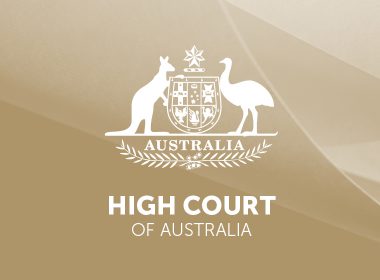Key decisions
- Deguisa v Lynn [2020] HCA 39
- Bursill Enterprises Pty Ltd v Berger Bros Trading Co Pty Ltd (1971) 124 CLR 73
- Westfield Management Ltd v Perpetual Trustee Co Ltd (2007) 233 CLR 528; [2007] HCA 45
- GBF v The Queen [2020] HCA 40
- Azzopardi v The Queen (2001) 205 CLR 50
REAL PROPERTY
Torrens system
In Deguisa v Lynn [2020] HCA 39 (4 November 2020) the High Court was required to consider whether the registered proprietors of a property had notice of, and were bound by, certain restrictive covenants in a common building scheme. The issue lies at the heart of the operation, and purpose, of the Torrens system of land.
The Torrens system is a matter of great pride for every South Australian property lawyer (and this South Australian born writer). Robert Torrens, an Irish immigrant who settled in South Australia, pioneered the system that bears his name – a system of land title by registration. The Torrens system is distinguished by a state guarantee that the certificate of title, produced by it, contains an accurate and comprehensive statement of the state of the title to that land. A person interested in a parcel of land need only look to the certificate of title, and the interests notified on it, to ensure that his or her dealing with the property does not miscarry. The Torrens system brought order to chaos and came to be adopted across Australia and even overseas by several countries.
Fittingly, the facts in this case also took place in South Australia. In 2008 the appellants became the registered proprietors of a property on Henley Beach Road in Fulham (the ‘Fulham Property’). They later successfully applied for planning approval to subdivide the Fulham Property into two lots and build two townhouses. The first and second respondents were the daughters of the original owner of a large parcel of land, Betty Fielder, which was subsequently subdivided into 54 smaller parcels of land and sold, in the mid-1960s, to a common building scheme. The Fulham Property was one such parcel of land (and had two previous owners prior to the appellants). The third respondent was the registered proprietor of two other parcels of land in the common building scheme. The respondents argued that the appellants were restrained by the restrictive covenants in the common building scheme from building multiple dwellings on the Fulham Property.
The appellants relied on s 69 of the Real Property Act 1886 (SA) (‘RPA’) which relevantly provides: ‘The title of every registered proprietor of land, shall subject to such encumbrances, liens, estates, or interests as may be notified on the certificate of title of such land, be absolute and indefeasible . . .’
The appellants argued that they had no notice of and, as such, were not bound by the restrictive covenants in the common building scheme. Although there is no provision in the RPA for the registration of a common building scheme, the respondents argued that the appellants did have sufficient notice of the restrictive covenant and were bound. The respondents pointed to the notation on the certificate of title to the Fulham Property which read (under the heading ‘Schedule of Dealings’) ‘Dealing Number / 265722’ and ‘Description / ENCUMBRANCE TO KEITH OLIVER AYTON AND BETTY JOAN FIELDER AS JOINT TENANTS’. A Memorandum of Encumbrance was filed by land broker A & HF Gaetjens Pty Ltd which stated ‘This encumbrance forms portion of a common building scheme’. All 54 lots, subject to the common building scheme, were depicted on a document described as the ‘Gaejens Plan’. The Gaejens Plan was not available on a search of the Lands Titles Office. Instead, it was found by one of the respondents after searching through Ms Fielder’s personal items after her death. The certificates of title issued for each of the 54 lots was also recorded on the ‘grandparent’ certificate of title for the original large parcel of land.
At first instance the primary judge found in favour of the respondents. The primary judge considered that the respondents did have standing to issue proceedings in their capacity as caveators to enforce the caveats. The primary judge also considered that the notation on the certificate of title to the Fulham Property gave the appellants sufficient notice and that the appellants should then have made further searches to ascertain the nature and extent of the common building scheme. The primary judge held that the restrictive covenants were binding on the appellants as part of the common building scheme with respect to the 52 allotments on the Gaejens Plan (which didn’t include two further, subsequent, allotments).
The appellants appealed unsuccessfully to the Full Court of the Supreme Court of South Australia. Peek J (with whom Hughes J agreed) considered that the ‘governing principle’ was stated by Windeyer J in Bursill Enterprises Pty Ltd v Berger Bros Trading Co Pty Ltd (1971) 124 CLR 73 (‘Bursill’) at 93 as ‘What is “notified” to the prospective purchaser by the vendor’s certificate of title is everything that would have come to his or her knowledge if a prudent conveyancer had made such searches as ought reasonably to have been made by him as a result of what appears on that certificate of title’. Peek J asserted that the appellants, having inspected the Memorandum of Encumbrance referred to in the certificate of title for the Fulham Property, would have been put on notice of the possible existence of a common building scheme and a prudent conveyancer would have conducted a search to identify other lots with mutually enforceable covenants. Kourakis CJ, in dissent, considered that the appellants were not notified because, he reasoned (referring to the reasons of Windeyer J and Barwick CJ in Bursill), that s 69 of the RPA did not contemplate a search for other certificates of title not referred to in the Memorandum of Encumbrance.
The appellants appealed again and, this time, were successful. The High Court unanimously allowed the appeal and, in a joint judgment, favoured the reasoning of Kourakis CJ in the Full Court decision. The High Court noted (at [53]) that the facts in Bursill concerned the misdescription of rights said to have been granted under ‘Transfer No 7922’. And (at [54]) that both Barwick QC and Windeyer J held that the purchaser was, nonetheless, sufficiently notified of the effect of Transfer No. 7922 because the true effect of transfer was immediately apparent on reading the instrument. The High Court (at [55] and [59]) cited passages from the reasons of both Barwick CJ and Windeyer J in which each judge expressed the view that it was incumbent on the purchaser to search for and inspect the registered dealing. The High Court considered (at [56] and [60]) that, in expressing such views, what their Honours both meant was that it was incumbent on the purchaser to search for, and inspect only those registered instruments notified on the certificate of title. The High Court observed (at [66]-[71]) that this reading of Bursill is consistent with the approach taken by the Court in the subsequent decision of Westfield Management Ltd v Perpetual Trustee Co Ltd (2007) 233 CLR 528; [2007] HCA 45 (‘Westfield‘) which approved of the reasons of both Barwick QC and Windeyer J in Bursill. The Court in Westfield accepted that, consistent with the objects of the Torrens system, only instruments notified by entry or memorial on the certificate of title are sufficiently notified on the certificate of title to defeat the otherwise unqualified title of the registered proprietor. The High Court, in the present case, reasoned (at [72]) that, consistent with the objects of the RPA, it would be necessary to have all of the lots benefiting from a restrictive covenant, in a common building scheme, identified on a certificate of title: ‘Such identification ensures that a potential purchaser is able to make fully informed decisions in relation to the concerned land’. It follows that the High Court concluded (at [73]-[87]) that the appellants were not notified and so were not bound by the restrictive covenants in the common building scheme.
CRIMINAL PRACTICE
Directions to jury
In GBF v The Queen [2020] HCA 40 (4 November 2020) the High Court was required to determine whether a trial judge had misdirected a jury by instructing the jury to ‘bear in mind that [the complainant] gave evidence and there is no evidence, no sworn evidence, by the defendant to the contrary of her account. That may make it easier’ (the impugned statement).
The defendant had been charged with seven counts of sexual offences against the complainant, the defendant’s half-sister. The conduct was said to have occurred in the period 1 December 2012 to 24 August 2013 when the defendant was 33 and 34 years of age and the complainant was just 13 and 14 years of age. The jury found the defendant guilty of all but two of the charges. The defendant unsuccessfully appealed to the Queensland Court of Appeal. Boddice J, in the leading judgment, recognised that the impugned statement conveyed a suggestion that the jury were entitled to, but deprived of, the defendant’s testimony. But Boddice J concluded there was no real possibility that the jury misunderstood the trial judge’s directions given that earlier, before making the impugned statement, the trial judge had given specific directions as to the presumption of innocence and neither counsel had made an application for any redirection at the time.
The High Court unanimously overturned the Court of Appeal’s decision finding that the trial judge’s direction was an irregularity amounting to a miscarriage of justice. In a single set of reasons, spanning 27 short paragraphs, the High Court ruled that, just as in Azzopardi v The Queen (2001) 205 CLR 50, the trial judge’s impugned statement contradicted his earlier direction on the onus of proof and invited the jury to engage in a similar false process of reasoning.



